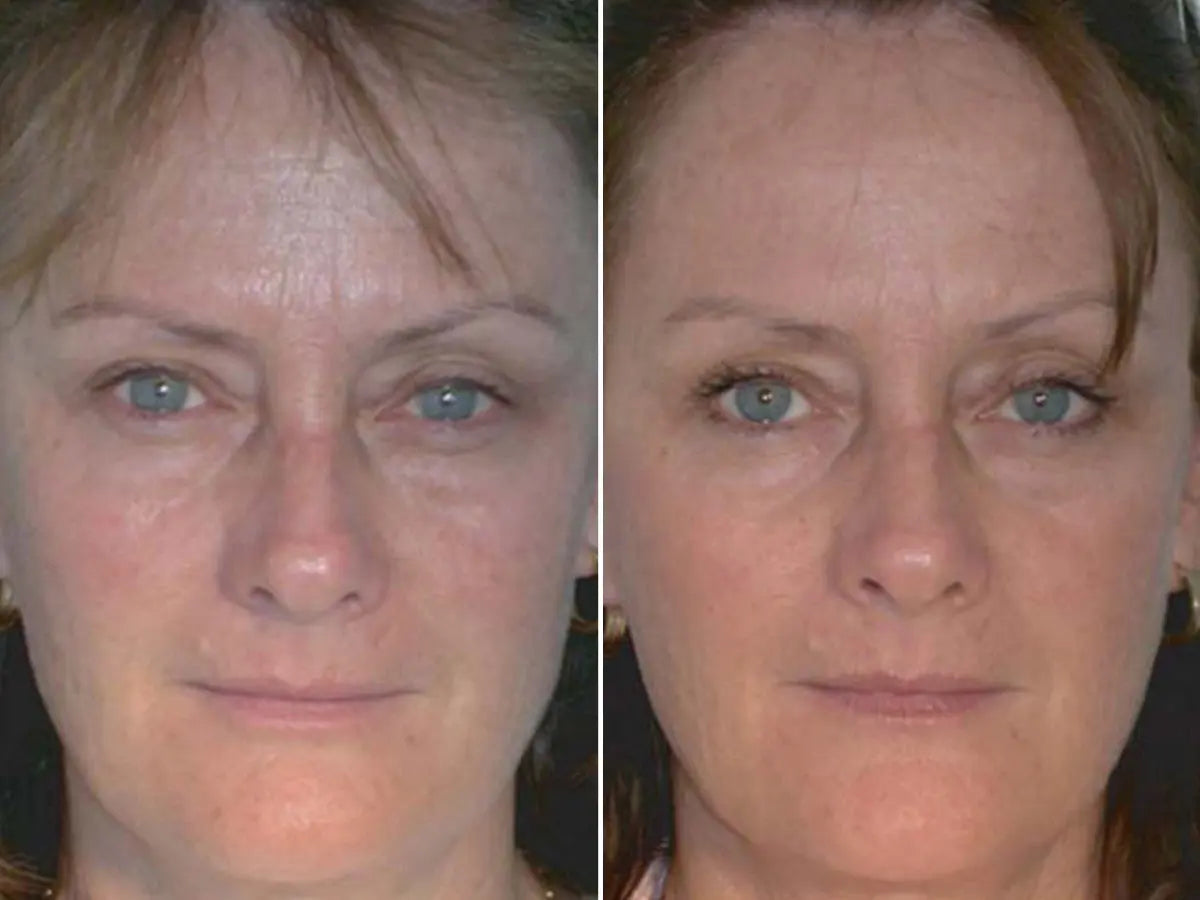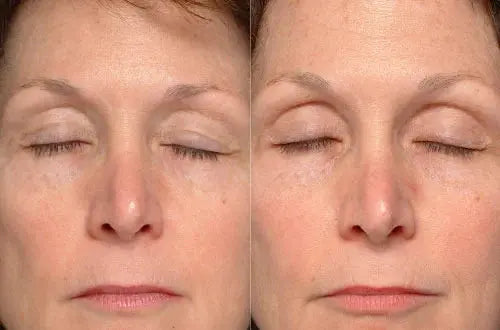Medically Reviewed by Dr. Lisa Hartford, MD
Skin pigmentation is a concern for many as it may make the skin appear dull and dark. The uneven dark patches on the skin may occur due to multiple reasons, such as sun exposure, wrong skin care, and delayed regeneration.
One of the best ways to prevent and target skin pigmentation is to use light therapy alongside good skin care and reducing sun exposure. Keep reading to know more about red light therapy for hyperpigmentation.
What is Skin Pigmentation?
Skin pigmentation refers to the shade of the skin due to melanin deposits under the surface. The natural skin color is the result of melanocytes producing melanin. Melanocytes have small melanosomes determining the color of the skin due to their unique size and function. Skin pigmentation may depend on genetics and ethnicity. The presence of chromosomes, including carotenoids, hemoglobin, melanin, and oxyhemoglobin, determines skin color.
When melanin skin cells are damaged/unhealthy, they can produce too much or uneven melanin. The melanin can clump, causing that area to appear darker. The presence of dark spots on the skin is known as hyperpigmentation. It may occur on the face or body in small or large irregular patches. Skin pigmentation looks different from the natural skin color.
Causes of Hyperpigmentation
Here are some causes of hyperpigmentation:
Sun exposure
It has been proven that the harsh ultraviolet rays from the sun lead to photoaging, skin aging, and dark spots. The rays from the sun may also cause melanin production in the skin. Melanin is the natural sunscreen in the skin, protecting it from burns and damage.

Sun exposure may result in tanning in some people. However, the skin may not produce an even amount of melanin to give a tan. This leads to patchy discoloration of the skin.
Skincare ingredients
Everyone has a different skin type. As a result, various skin care ingredients have a unique impact. Some products, such as retinol, vitamin C, acidic peels, and benzoyl peroxide, may be a cause of hyperpigmentation.
The chemicals present in skin care may lead to dark spots on the skin. In addition, using retinol and vitamin C can make the skin photosensitive, causing it to be more sun damage prone. Due to this, the sun may cause burns and hyperpigmentation. That's why it's recommended to use sunblock when using these ingredients.
Health conditions
Several health conditions may also be the cause of hyperpigmentation. These may be genetic or develop over time. For instance, melasma in the skin is triggered by hormonal changes, such as those occurring during pregnancy or with the use of birth control pills. Melasma causes multiple dark patches, usually on the face. This impact of hormonal change is more common in women.
Next, Addison's disease may also be a culprit in causing hyperpigmentation on the lips and skin on the face. It's a rare condition where the adrenal glands do not produce enough hormones. Some people may have hemochromatosis, which is a genetic disorder. The disorder makes the body absorb too much iron from the diet. This excess iron may cause the skin to become darker around the joints and knuckles.
Skin inflammation
When the skin is inflamed due to various factors like allergies, irritants, or dermatitis, the body responds by producing excess melanin in the affected areas. This can result in dark patches or spots. Conditions like eczema and psoriasis skin inflammation lead to hyperpigmentation in some cases. Allergies from skin care ingredients may also cause eczema.
Those who have skin injuries such as burns, infections, and rashes may get post-inflammatory hyperpigmentation (PIH). It occurs on the site of the skin injuries. As the wound heals, the pigmentation may resolve over time.
Acne and wound scars
When the skin experiences injury or inflammation due to acne or wounds, it may respond by producing more melanin, leading to dark marks or spots. Acne scars, especially in individuals with deeper skin tones, often leave behind residual pigmentation. This pigmentation is challenging to fade.
Other factors, such as picking on the skin or squeezing acne, cause skin inflammation and the likelihood of developing hyperpigmentation in those areas. If your skin has cuts, burns, and surgical incisions, it may result in scar formation and potential hyperpigmentation. Special care is essential when your skin is subjected to any kind of trauma to prevent scarring and skin pigmentation.
Can Red Light Therapy Help Hyperpigmentation
Over the years, red light therapy has gained popularity for its multiple skin benefits. From stimulating collagen to improving the appearance, red light may help in skin rejuvenation. With consistent use, this non-invasive skin treatment may have a major change in appearance.

One of the major reasons red light works so well on skin hyperpigmentation is that our skin can absorb the red light. The wavelength of red light is 620 to 750 nm and has the ability to penetrate 2-4mm deep into the dermis. Red LED reaches the mitochondria(the power plant of the cell) to trigger cellular changes in the growth.
As a result, the cells absorb the light and trigger cell repair. This enables the cells to work on damaged cells and remove pigmented cells. Moreover, the old cells are able to shed the hyperpigmented layers to trigger the production of new healthy skin cells.
The science behind red light therapy
In a recent study, the effect of red and near-infrared on skin rejuvenation was studied. One hundred thirty-six volunteers participated in the randomized clinical trial. Out of the total participants, 113 subjects were divided into four different treatment groups. They were randomly treated twice a week with either 611–650 or 570–850 nm polychromatic light, which was normalized to ∼9 J/cm2 in the range of 611–650 nm.
Each group had a different duration of treatment. They were then compared to those who were not given the LED treatment. After the treatment was over, blinded data was calculated after thirty sessions. The data included collagen density of the skin, photography, digital profilometry, and self-assessment. This data was compared to the information collected before the trial.
As per the comparisons, those who were treated with red light had an improvement in the complexion of the skin. The texture was also reduced when skin roughness was assessed. Therefore, the study concluded red light therapy can be effectively used for safe skin rejuvenation and collagen stimulation for cell repair.
At-Home Red LED Therapy
Try the EvenSkyn Mirage LED face mask with professional grade 204 LED. It uses photobiomodulation to treat the photoaged skin. With a power of up to 500 joules, it offers skin rejuvenation at home.
The mask has three light modes–red, blue, and yellow. The red LED is ideal for collagen stimulation and reducing the appearance of fine lines. Blue light is for acne reduction as it is known to diminish acne-causing bacteria from the skin. Lastly, yellow light is for total skin rejuvenation by promoting healing.

Mirage comes with an adjustable strap and eye protection for safe use. In addition, it is certified by the FDA, Health Canada, CE, RoHS, and BSCI. So, if you are looking for an at-home LED therapy, it's a durable and safe choice.
To use the mask, clean your skin and wear the mask snugly on the face. Use the remote to control the light color and intensity. You may manually change the colors as per your needs. The mask also has an automatic feature that changes the light color for total skin rejuvenation. You may use the mask three times a week for 25 minutes for a full facial session. Within 6-8 weeks of use, you may notice an improvement in fine lines and texture.
Wrapping Up
A new understanding of skin pigmentation and aging is a great insight into using healing measures. Photoaging and pigmentation due to UV rays is an inescapable scenario; however, you may use red LED therapy, sun protection, and reduce exposure.
With the right skincare and consistent therapy, you can safeguard your skin from developing hyperpigmentation. Delving into red light therapy will not only soothe photoaged skin but may also diminish the appearance of fine lines and wrinkles. Also, patch-test products that are known to be causing pigmentation are crucial when it comes to prevention.
References:
- Veierod MB, Weiderpass E, Thörn M, Hansson J, Lund E, Armstrong B, Adami HO. "A prospective study of pigmentation, sun exposure, and risk of cutaneous malignant melanoma in women." 2003 Oct
- Daniel I. Schlessinger; McDamian Anoruo; Joel Schlessinger. "Biochemistry, Melanin." May 2023
- Wunsch A, Matuschka K. "A controlled trial to determine the efficacy of red and near-infrared light treatment in patient satisfaction, reduction of fine lines, wrinkles, skin roughness, and intradermal collagen density increase." 2014 Feb
- Gold MH, Andriessen A, Biron J, Andriessen H. "Clinical Efficacy of Self-applied Blue Light Therapy for Mild-to-Moderate Facial Acne." 2009 Mar
- Gold MH, Andriessen A, Biron J, Andriessen H. "Clinical Efficacy of Self-applied Blue Light Therapy for Mild-to-Moderate Facial Acne." 2009 Mar
- Sawada Y, Saito-Sasaki N, Mashima E, Nakamura M. "Daily Lifestyle and Inflammatory Skin Diseases." 2021 May 14
- Kim JC, Park TJ, Kang HY. "Skin-Aging Pigmentation: Who Is the Real Enemy?" 2022 Aug









Leave a comment
All comments are moderated before being published.
This site is protected by hCaptcha and the hCaptcha Privacy Policy and Terms of Service apply.